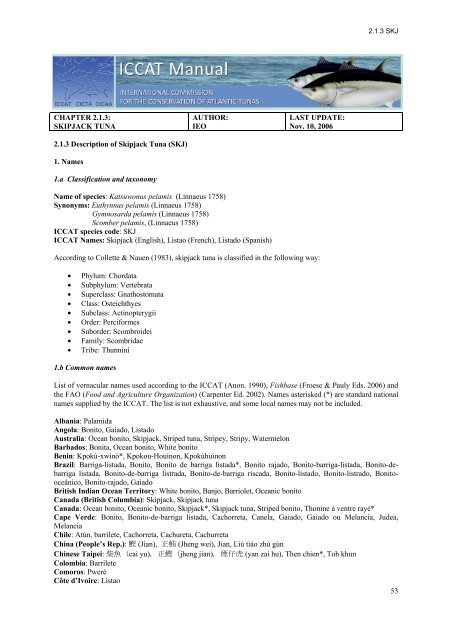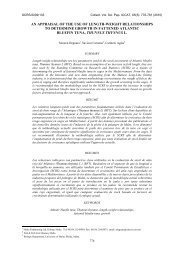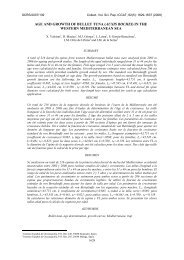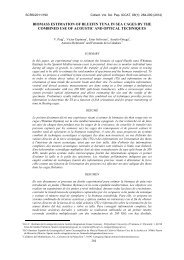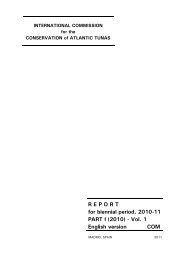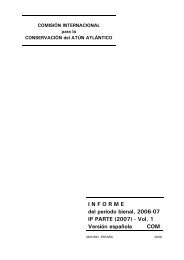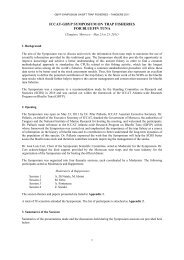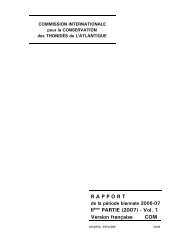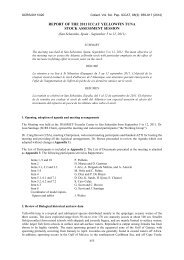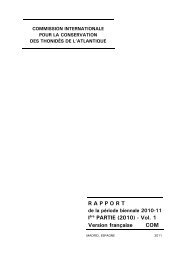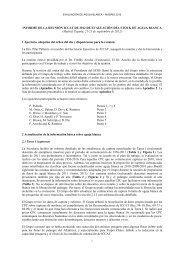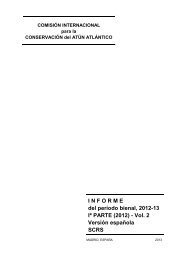You also want an ePaper? Increase the reach of your titles
YUMPU automatically turns print PDFs into web optimized ePapers that Google loves.
CHAPTER <strong>2.1.3</strong>:<br />
SKIPJACK TUNA<br />
<strong>2.1.3</strong> Description of <strong>Skipjack</strong> Tuna (SKJ)<br />
1. Names<br />
1.a Classification and taxonomy<br />
Name of species: Katsuwonus pelamis (Linnaeus 1758)<br />
Synonyms: Euthynnus pelamis (Linnaeus 1758)<br />
Gymnosarda pelamis (Linnaeus 1758)<br />
Scomber pelamis, (Linnaeus 1758)<br />
ICCAT species code: SKJ<br />
ICCAT Names: <strong>Skipjack</strong> (English), Listao (French), Listado (Spanish)<br />
According to Collette & Nauen (1983), skipjack tuna is classified in the following way:<br />
• Phylum: Chordata<br />
• Subphylum: Vertebrata<br />
• Superclass: Gnathostomata<br />
• Class: Osteichthyes<br />
• Subclass: Actinopterygii<br />
• Order: Perciformes<br />
• Suborder: Scombroidei<br />
• Family: Scombridae<br />
• Tribe: Thunnini<br />
1.b Common names<br />
AUTHOR:<br />
IEO<br />
LAST UPDATE:<br />
Nov. 10, 2006<br />
<strong>2.1.3</strong> SKJ<br />
List of vernacular names used according to the ICCAT (Anon. 1990), Fishbase (Froese & Pauly Eds. 2006) and<br />
the FAO (Food and Agriculture Organization) (Carpenter Ed. 2002). Names asterisked (*) are standard national<br />
names supplied by the ICCAT. The list is not exhaustive, and some local names may not be included.<br />
Albania: Palamida<br />
Angola: Bonito, Gaiado, Listado<br />
Australia: Ocean bonito, <strong>Skipjack</strong>, Striped tuna, Stripey, Stripy, Watermelon<br />
Barbados: Bonita, Ocean bonito, White bonito<br />
Benin: Kpokú-xwinò*, Kpokou-Houinon, Kpokúhuinon<br />
Brazil: Barriga-listada, Bonito, Bonito de barriga listada*, Bonito rajado, Bonito-barriga-listada, Bonito-debarriga<br />
listada, Bonito-de-barriga listrada, Bonito-de-barriga riscada, Bonito-listado, Bonito-listrado, Bonitooceânico,<br />
Bonito-rajado, Gaiado<br />
British Indian Ocean Territory: White bonito, Banjo, Barriolet, Oceanic bonito<br />
Canada (British Columbia): <strong>Skipjack</strong>, <strong>Skipjack</strong> tuna<br />
Canada: Ocean bonito, Oceanic bonito, <strong>Skipjack</strong>*, <strong>Skipjack</strong> tuna, Striped bonito, Thonine à ventre rayé*<br />
Cape Verde: Bonito, Bonito-de-barriga listada, Cachorreta, Canela, Gaiado, Gaiado ou Melancia, Judea,<br />
Melancia<br />
Chile: Atún, barrilete, Cachorreta, Cachureta, Cachurreta<br />
China (People’s Rep.): (Jian), (Jheng wei), Jian, Liù tiáo zhú gùn<br />
Chinese Taipei: cai yu)jheng jian) (yan zai hu), Then chien*, Toh khun<br />
Colombia: Barrilete<br />
Comoros: Pweré<br />
Côte d’Ivoire: Listao<br />
53
ICCAT MANUAL, 1st Edition (January 2010)<br />
Cuba: Atún, Bonito listado, Merma<br />
Denmark: Bugstribet bonit, Bugstribet bonnit<br />
Djibouti: Machaket<br />
Dominican Republic: Bonito<br />
Ecuador: Picosa, Rayada<br />
Egypt: Tunna<br />
Fiji: I' a seu<br />
Fiji Islands: <strong>Skipjack</strong> tuna<br />
Finland: Boniitti<br />
France: Bonite, Bonite à ventre rayé*, Bonitou, Bounicou, Listao<br />
French Polynesia: Atu, Bonito<br />
Germany: Bauchstreifiger Bonito, Bonito, Echter Bonito*, Thunfisch<br />
Greece: Ρίκι, Τονοπαλαμίδα, Λακέρδα, Παλαμίδα, Lacérda, Palamída, Pelamis, Pelamys, Riki, Tonina,<br />
Tonopalamida<br />
Guinea: Makréni<br />
Hawaii: Aku, Aku kina'u, <strong>Skipjack</strong> tuna fish<br />
India: बुगुदी (Bugudi), Choora, ചൂര (Choora), Gedar, िगदार (Gedar), Bokado, Bonito, Bugudi, Kalabila-mas,<br />
Kali-phila-mas, Kuppa, कु पा (Kuppa), Metti, Oceanic skipjack, <strong>Skipjack</strong> tuna, Skiy jack, Striped tuna, Stripped<br />
tuna, Varichoora<br />
Indonesia: Cakalang, Kausa, Tjakalong, Tjakalong lelaki, Tjakalong merah, Tjakalong perempuan, Wandan<br />
Iran: Havoor-e-masghati<br />
Isle of Man: Bonito<br />
Israel: Balanida<br />
Italy: Culurita, Impiriali, Nzirru, Paamia, Paamitun, Palamatu, Palametto, Palamida, Palamitu, Palamitu<br />
imperiali, Palometta, Tonnetto, Tonina de Dalmazia, Tonnetto striato<br />
Japan: Club mackerel, Hongatsuo, Katsuo*, Katsuwo, Magatsuwo, Mandagatsuwo, Mandara<br />
Kenya: Jodari, Sehewa, <strong>Skipjack</strong><br />
Kiribati (Christmas Islands): <strong>Skipjack</strong> tuna<br />
Kiribati: Te ati, Te atu<br />
Korea: Ga-da-raeng-i*, Gang-go-deung-so, Da-raeng-i<br />
Korea (Rep. of.): Da-raeng-i, Ga-da-raeng-i, Ga-da-ri, Gang-go-deung-so, Ka-da-raeng-i, Ka-da-raeng-o, Mogmaen-dung-i,<br />
So-young-chi, Yeo-da-raeng-i<br />
Madagascar: Bonite, Bonite à ventre rayé, Diodary, Lamatra, M'bassi<br />
Malaysia: Aya, Bakulan, Kayu, Tongkok, Tongkol jepun<br />
Maldive Islands: Godhaa, Kadumas, <strong>Skipjack</strong> tuna<br />
Malta: Palamit, Pelamit, Plamtu, Plamtu imperjali<br />
Marshall Islands: Chilu, Lojabwil<br />
Martinique: Bonite à ventre rayé, Bariolé<br />
Mauritania: Bonite à ventre rayé, Listado, Listao, <strong>Skipjack</strong><br />
Mauritius Islands : Bonite à ventre rayé, Bonite acumine<br />
Mexico: Barrilete, Barrilete listado, Listado<br />
Micronesia: Garengaap-garengaap, Katsuo, Ligaasimwai, Liyaubesh, <strong>Skipjack</strong> tuna<br />
Monaco: Bonita, Bunita<br />
Morocco: L'bakoura, Listao<br />
Mozambique: Gaiado<br />
Namibia: Bauchstreifiger bonito, Bonito, Echter Bonito, Gestreifter Thunfisch, Pensstreep-tuna, Tuna<br />
Netherlands Antilles (Papiamento): Buni karèt, Buni porko<br />
Netherlands (Holland): Gestreepte tonijn<br />
New Caledonia: Bonite à ventre rayé, Bonite folle, Mwaali<br />
New Zealand (Niue): Takua, <strong>Skipjack</strong> tuna<br />
New Zealand (Tokelau): Atu, Nakono, Tuikaufoe<br />
New Zealand: Bonito, <strong>Skipjack</strong>, <strong>Skipjack</strong> tuna, Skipper, Striped bonito, Striped tunny<br />
Nicaragua: Listado<br />
Norway: Bonit, Bukstripet bonitt, Stripet pelamide<br />
Oman: Sadah, Shewa, Thoqaibeh<br />
Palau (Trust territories of the Pacific Islands): Katsuo, Tuna<br />
Papua N. Guinea: <strong>Skipjack</strong> tuna, Striped tuna, Tjakalang<br />
Peru: Barrilete<br />
54
<strong>2.1.3</strong> SKJ<br />
Philippines: Agtun, Bangkulis, Bankulis, Bariles, Barilis, Batala-an panit, Bolis, Budlis, Budlisan, Bulis,<br />
Buslugan, Golyasan, Gulyaman, Gulyangan, Gulyasan, Karaw, Ocean bonito, Palawayan, Panit, Pawayan,<br />
Poyan, Pundahan, Puy-yan, Puyan, Rayado, Sambagon, <strong>Skipjack</strong>, <strong>Skipjack</strong> tuna, Sobad, Striped tuna, Tangi,<br />
Tulingan, Turingan<br />
Poland: Bonite, Bonito<br />
Portugal (Azores): Bonito*, Gaiado, Ocean bonito, <strong>Skipjack</strong> tuna<br />
Portugal (Madeira): Gaiado<br />
Portugal: Atum-bonito, Bonito, Bonito de ventre raiado, Bonito-de-barriga listada, Gaiado, Gayado, Listado,<br />
Sarrajao, Serra<br />
Reunion: Bonite calou, Bonite ventre rayé<br />
Romania: Palamida, Palamida lacherda, Ton dungat, Ton zebrat<br />
Russian Fed.: Katsuo, Malayj tunets-bonito , Okeanskij bonito, Polosatyi tunets, Polosatyj tunets*, Skipdzhek<br />
Samoa: Atu, Faolua, Ga'ogo<br />
Sao Tomé and Prín.: Atum judeu<br />
Senegal: Bonite à ventre rayé, Kiri-kiri<br />
Seychelles: Bonite folle, Ton rayé<br />
Sierra Leone: <strong>Skipjack</strong> tuna<br />
Slovenia: Èrtasti tun<br />
Solomon Islands: Atu, <strong>Skipjack</strong> tuna<br />
Somalia: Jaydar dhiiglow, Sehewa<br />
South Africa: Bonito, Katunkel, Lesser tunny, Ocean bonito, Oceanic bonito, Pensstreep-tuna, <strong>Skipjack</strong>*,<br />
<strong>Skipjack</strong> tuna, Watermelon<br />
Spain (Canary Islands): Bonito, Listado<br />
Spain: Alistado, Atún de altura, Bonita, Bonito de altura, Bonito de vientre rayado, Bonito del sur, Bonitol,<br />
Bonítol de ventre ratllat, Lampo, Listado*, Llampua, Palomida, <strong>Skipjack</strong><br />
Sri Lanka: Balaya, Bonito, Scorai<br />
Sweden: Bonit<br />
Surinam: White bonito, Oceanic bonito<br />
Tahiti: 'Authopu, A'u, Atu, Auaeroa, Auhopu, Auhopu tore, Kopukopu, Pa'amea, Pa'amoa, Pirara, Poarahi,<br />
Tari'a'uri, Tau, Tohe'o'o, Toheveri, Tore<br />
Tanzania: Sehewa, Zunuba<br />
Tonga (Polynesia): 'Atu, <strong>Skipjack</strong> tuna<br />
Trinidad and Tobago: Bonito, Macrio, <strong>Skipjack</strong><br />
Tuamotu (French Polynesia): Auhopo, Toheveri<br />
Tunisia: Bonite, Boussenna, Ghzel<br />
Turkey: Çizgiliorkinoz baligi, Çizgiliton baligi<br />
United Kingdom (Santa Helena): Bonito<br />
United Kingdom: Atlantic bonito, Bonito, Ocean bonito, <strong>Skipjack</strong>, <strong>Skipjack</strong> tuna, Striped bellied bonito, Striped<br />
bellied tunny<br />
United States (North Marianas): Anga-rap, Yárengaap, Kacho<br />
United States: Arctic bonito, Bonito, Mushmouth, Ocean bonito, Oceanic bonito, Oceanic skipjack, <strong>Skipjack</strong>,<br />
<strong>Skipjack</strong> tuna*, Skippy, Striped bonito, Striped tuna, Victor fish, Watermelon<br />
Venezuela: Barrilete, Bonito, Bonito oceánico, Listado*<br />
Vietnam: <strong>Skipjack</strong> tuna, Cá Ng vn<br />
Yemen: Af muss, Dabub, Hargheiba<br />
55
ICCAT MANUAL, 1st Edition (January 2010)<br />
2. Identification<br />
Figure 1. Drawing of an adult skipjack tuna, courtesy of the FROM (Fondo de Regulación y Organización del<br />
Mercado de los productos de la pesca y cultivos marinos/Fund for Regulation and Organisation of the Market in<br />
fishery products and marine crops) – Ministry of Agriculture, Fisheries and Food, Spain (Anon. 1985).<br />
Characterístics of Katsuwonus pelamis (see Figure 1 and Figure 2)<br />
The maximum recorded size is 108 cm (34.5 kg weight) according to Collette & Nauen (1983), although<br />
maximum sizes in catches tend not to exceed 80 cm (8-10 kg).<br />
The maximum age cited for this species is 12 years (Froese & Pauly 2006).<br />
External characteristics:<br />
56<br />
Fusiform, elongated and rounded body.<br />
Single row of small, conical teeth.<br />
Without body scales except for corselet and lateral line.<br />
Two dorsal fins separated by a narrow interspace (no larger than the eye).<br />
First dorsal with 14-17 spines and second dorsal with 12-16 soft radii, followed by 7-10 finlets. The<br />
pectoral fin is short, with 24 or 32 radii. Anal fin composed of 13-17 soft radii, followed by 6-8 finlets<br />
(Richards 2006).<br />
Prominent keel on either side of the caudal fin base, between two smaller keels.<br />
Interpelvic process small and bifid.<br />
Colour:<br />
Dark purplish blue back. Lower sides and belly silvery.<br />
4 to 6 very conspicuous longitudinal dark bands which in live specimens may appear as continuous<br />
lines of dark blotches.<br />
Internal characteristics:<br />
Branchiospines on first branchial arc.<br />
Vertebrae: 20 precaudal and 21 caudal.<br />
Swim bladder absent.
<strong>2.1.3</strong> SKJ<br />
Figure 2. Diagram of outstanding features of Katsuwonus pelamis (based on Collette 1995, In Froeser & Pauly<br />
Eds. 2006. Modified by the IEO).<br />
External characteristics of skipjack larvae<br />
• Narrow body.<br />
• Small, fresh specimens are diagnosed by the presence of a pattern of red marks (erythrophores) in the<br />
caudal region (Uyeanagi 1966).<br />
• Superficial melanophore (black pigmentation) in the anterior region of the brain, present in larvae > 4<br />
mm SL (standard length).<br />
• Absence of black pigmentation from isthmus to anterior part of anus.<br />
• Occasional black pigmentation on the dorsal edge of the caudal peduncle. Several blotches of black<br />
pigmentation on the ventral edge of the caudal fin (Dicenta 1975) and occasional black pigmentation on<br />
the dorsal edge of the caudal peduncle.<br />
• Melanophore on the end of the lower jaw. The end of the upper jaw points noticeably down towards the<br />
lower jaw (from 7.8 mm of TL).<br />
• Slight black pigmentation (Chow et al. 2003) on first dorsal fin, in larvae > 8 mm of SL.<br />
3. Biology and population studies<br />
3.a Habitat<br />
53-63<br />
branchiospines<br />
on first gill arch<br />
LF<br />
14-17 hard radii<br />
24-32 soft radii 4-6 dark bands<br />
12-16 soft radii<br />
13-17<br />
soft radii<br />
7-20 finlets<br />
6-8<br />
finlets<br />
Prominent<br />
keel<br />
Epipelagic species generally inhabiting open waters. Aggregations of this species tend to be associated with<br />
convergences, boundaries between cold and warm water masses, outcrops and other hydrographic discontinuities<br />
(Collette & Nauen 1983).<br />
Temperature: skipjack tuna can be found in waters with temperatures ranging from 15ºC to 30ºC, but they<br />
normally inhabit waters where the surface temperature is between 20ºC and 30ºC (Forsbergh 1980). They<br />
generally dive only to depths where the water temperature does not reach more than 8ºC below the temperature<br />
on the surface layer (Brill et al. 2005).<br />
Depth: depth distribution ranges from the surface to about 260 m during the day, remaining close to the surface<br />
during the night (Collette & Nauen op. cit.).<br />
57
ICCAT MANUAL, 1st Edition (January 2010)<br />
Dissolved oxygen: Barkley et al. (1978), Cayré (1987) and Evans et al. (1981) established 3.0-3.5 ml l -1 (5 ppm)<br />
as minimum values of dissolved oxygen in water for the skipjack tuna habitat where temperature and other<br />
variables are not limiting factors. This factor generally restricts skipjack tuna to waters above the thermocline<br />
(Sharp 1978).<br />
Notwithstanding the values cited above, in an experiment Levenez (1982) reported recordings of skipjack tuna<br />
with acoustic tags in which brief dives as deep as 400 m were observed, with temperatures below 14ºC and an<br />
oxygen level close to 1.5 ml l -1 .<br />
3.b Growth<br />
In the course of the International <strong>Skipjack</strong> Year programme (Anon. 1986) conducted between 1979 and 1982,<br />
various growth models were analysed for the eastern Atlantic (Antoine et al. 1982, Bard & Antoine 1986, Chur<br />
et al. 1986) and differences were found in growth rates depending on the year and the zone of the survey. It was<br />
concluded from these analyses that fish in equatorial zones (Gulf of Guinea) grow more slowly than those in<br />
subtropical zones (Senegal-Cape Verde) (Cayré 1979, Cayré et al. 1986a). This seasonal and geographic<br />
variability of growth has been confirmed by studies of modal size progressions (Bard & Antoine op. cit., Cayré<br />
et al. 1986b) and analyses of tagging data (Bard & Antoine op. cit., Cayré et al. 1986b).<br />
For the equatorial zone (5ºN-5ºS), with a constant year-round temperature and scanty trophic resources, the<br />
ICCAT uses the parameters from the von Bertalanffy equation (1938) proposed by Bard & Antoine (op. cit.),<br />
which describe slow growth in the region of 1 cm/month for the range of sizes fished in this area.<br />
As regards the northern tropical zone (Cape Verde – Senegal), the equation of Cayré et al. (op. cit.), used by the<br />
ICCAT until 1999, was compared with other growth equations for the western and eastern Atlantic (Anon.<br />
1999). It was found that the fast growth rate suggested by these authors for the first year (15 cm/year on average,<br />
peaking in summer) exceeded the average annual growth rate proposed by all other studies (Figure 3). In 2006,<br />
Hallier & Gaertner presented a new study on growth in this zone based on the tagging data from Senegal and<br />
Mauritania.<br />
In the western Atlantic there are also differences depending on year and zone (Batts 1972, Carles-Martin 1975).<br />
In the case of the South-East Caribbean zone, where the sizes caught are larger than in the eastern Atlantic, the<br />
ICCAT uses the model presented by Pagavino & Gaertner (1995) based on modal progression analysis<br />
(MULTIFAN) of the six-year data set. Two annual recruitments have been observed. In the case of southern<br />
Brazilian waters, the model used is one formulated by Vilela & Castello (1991) and supported by Matsura &<br />
Andrade (2000), who conducted growth studies based on data from the reading of cuts on the first ray of the first<br />
dorsal fin.<br />
Table 1. Growth parameters used by the ICCAT for skipjack tuna (Lt in cm, t in years).<br />
Growth equations<br />
Lt<br />
*Where Lt =length at age t.<br />
58<br />
Authors<br />
<br />
0.<br />
322t<br />
e <br />
Bard & Antoine (1986)<br />
80 . 0 1<br />
<br />
0.<br />
218 t2. 09<br />
87.<br />
12 1<br />
Vilela & Castello (1991)<br />
L t e<br />
<br />
Lt<br />
Lt<br />
<br />
94.<br />
9<br />
340t<br />
1e 0.<br />
251t<br />
1e Pagavino & Gaertner<br />
(1995)<br />
Hallier & Gaertner (2006)<br />
97.<br />
258<br />
n<br />
341<br />
? ?<br />
?<br />
222<br />
Length range<br />
(FL in cm)<br />
40 – 65 cm<br />
38 – 96 cm<br />
40 – 65 cm<br />
Methodology<br />
Tagging<br />
Radii<br />
MULTIFAN (size<br />
frequency analysis)<br />
Tagging;<br />
Meta-analysis<br />
Stock/Zone<br />
Equatorial eastern<br />
Atlantic<br />
(sexes pooled)<br />
Western Atlantic<br />
(Southern Brazil)<br />
(sexes pooled)<br />
Western Atlantic<br />
(Caribbean)<br />
(sexes pooled)<br />
Eastern Atlantic (Cape<br />
Verde-Senegal)<br />
(sexes pooled)
Figure 3. Comparison of some growth curves proposed by several authors (Anon. 1999).<br />
3.c Biometric relationships<br />
<strong>2.1.3</strong> SKJ<br />
Since 1986 a single size (FL)-weight (W) relationship has been used for skipjack tuna in the Atlantic Ocean.<br />
This equation, defined by Cayré & Laloë (1986), is applied to males and females alike.<br />
Before this research, the equations used were ones formulated by Lenarz (1971) and Pianet (1974), which were<br />
accepted by the ICCAT until 1986. The values found by Amorim et al. (1981) in south-east Brazilian waters<br />
were similar to these.<br />
The latest works published by Brazilian scientists (Vilela & Castello 1991) with skipjack tuna from that zone<br />
agree with the relationship cited by Amorim et al. (op. cit.).<br />
Table 2. Biometric size-weight relationship currently used by the ICCAT.<br />
Equation<br />
W 7. 480 10<br />
FL<br />
* Where W=weight; FL=fork length<br />
3.d Maturity<br />
Authors<br />
6 3.<br />
253<br />
Cayré & Laloë (1986)<br />
On the basis of histological studies of skipjack tuna in the tropical Atlantic, Cayré & Farrugio (1986) concluded<br />
that the skipjack is an opportunistic breeder, given that it is capable of reproducing wherever water conditions<br />
are suitable. According to these authors, the size at first maturity is 42 cm for females and 45 cm for males in the<br />
eastern Atlantic, including Brazilian waters.<br />
According to Vilela & Castello (1993), the size at first maturity in the South-West Atlantic is 51 cm for females<br />
and 52 cm for males, corresponding to an age of 2 years.<br />
The size established at first maturity for skipjack caught in Canary Island waters and off the west coast of Africa,<br />
where at least 40% of individuals are mature, is around 47 cm for females and 50 cm for males (García Vela &<br />
Santos Guerra 1984).<br />
A study conducted by Hazin et al. (2001) in the equatorial zone of the Atlantic Ocean established the size at first<br />
maturity as 45 cm for females and 48 cm for males.<br />
n<br />
Length range (FL<br />
in cm)<br />
14 140 32 – 78 cm<br />
Stock<br />
Atlantic<br />
59
ICCAT MANUAL, 1st Edition (January 2010)<br />
Table 3. Sizes at first maturity in the Atlantic.<br />
Maturity Reference Area<br />
40% mature females measuring 47 cm García Vela & Santos Guerra (1984) Eastern Atlantic<br />
40% mature males measuring 50 cm García Vela & Santos Guerra (1984) Eastern Atlantic<br />
50% mature females measuring 42 cm Cayré & Farrugio (1986) Eastern Atlantic and Brazil<br />
50% mature males measuring 45 cm Cayré & Farrugio (1986) Eastern Atlantic and Brazil<br />
50% mature females measuring 51 cm Vilela & Castello (1993) Southwestern Atlantic<br />
50% mature males measuring 52 cm Vilela & Castello (1993) Southwestern Atlantic<br />
50% mature females measuring 45 cm Hazin et al. (2001) Atlantic<br />
50% mature males measuring 48 cm Hazin et al. (2001) Atlantic<br />
3.e Proportion of sexes<br />
There are numerous studies on the ratio of sexes in skipjack tuna. The conclusions are similar in all cases and<br />
differ substantially from those for other tunas like the yellowfin or the bigeye. In this case there is a slight but<br />
non-significant predomination of the female for practically all size categories. Differences have not generally<br />
been found in the ratio of sexes in the different size categories or in different fishing areas (Castello & Habiaga<br />
1989, Cayré 1981, Ramos et al. 1991).<br />
Cayré (op. cit.) conducted an important study on the West African coast from the equator to 20ºN and reported a<br />
ratio of 0.953 (males/females). In other words, males and females were in almost equal proportion irrespective of<br />
the size considered, although there was a tendency towards abundance of males in the categories over 60 cm FL.<br />
García Vela & Santos Guerra (1984) analysed 1781 specimens in the region of the Canary Islands and the West<br />
Coast of Africa and found a ratio of 0.896 (males/females) in the size range 38-78 cm FL.<br />
In South-West Brazil, Jablonski et al. (1984) analysed 3429 gonads and found that the number of males was<br />
significantly greater than the number of females only in the months of November-December and in April (peak<br />
breeding periods) and only in the size categories 45-49 cm and 60-64 cm FL.<br />
Cayré & Farrugio (1986) analysed 16 720 specimens by zone between 1977 and 1983. They found that in island<br />
areas there were peculiarities such as an imbalance in favour of females in the Azores and the Canary Islands in<br />
some months of the year, and that excepting the size category 35-39 cm FL there were no differences in the ratio<br />
of males to females (0.990), with males predominating only in sizes exceeding 60 cm FL. Figure 4 shows the<br />
areas sampled by Cayré & Farrugio (op. cit.), and the table next to it shows the proportion of sexes found in<br />
these areas and the numbers of specimens analysed. Pereira (1986) confirmed this hypothesis, reporting a ratio of<br />
sexes of 0.697 (males/females), which was especially high in categories over 45 cm FL.<br />
These data are similar to those reported by Orange (1961) in the Pacific Ocean and by Stéquert (1976) in the<br />
Indian Ocean, except that the balance of sexes inclines towards males from 75 and 55 cm FL upwards,<br />
respectively.<br />
60
Figure 4. Areas chosen for a survey of proportions of sexes in skipjack tuna (Cayré & Farrugio 1986).<br />
3.f Reproduction<br />
<strong>Skipjack</strong> tuna breed opportunistically throughout the year over wide areas of the Atlantic.<br />
Spawning<br />
<strong>2.1.3</strong> SKJ<br />
According to various authors, spawning in a school is a synchronised process. However, it is also the case that<br />
skipjacks at the reproductive stage are observed in all waters where the surface temperature is at least 24ºC.<br />
Thanks to a very rapid process of sexual maturing and consequently rapid oocyte hydration, skipjacks are able to<br />
reproduce as soon as they find water conditions favourable (Cayré & Farrugio 1986, Vilela & Castello 1993).<br />
This strategy allows for more efficient utilisation of oceanic regions that are favourable to spawning and larval<br />
growth (Vilela & Castello op. cit.).<br />
In the eastern Atlantic skipjacks spawn over a wide area on either side of the equator, from the Gulf of Guinea to<br />
20º-30ºW. Spawning occurs all the year round, peaking between November and March (Anon. 1999). The work<br />
by Cayré & Farrugio (op. cit.) shows how spawning seasons differ according to the zone. In the north of this area<br />
(Guinea Bissau, Senegal, Cape Verde, Mauritania, Canary Islands, Morocco, Azores) spawning is spread over<br />
the second and third quarters of the year, while in the southern part (Sherbro, Liberia, Ivory Coast, Ghana and<br />
Cape Lopez) spawning mainly takes place during the fourth and first quarters.<br />
In the western Atlantic there is a spawning area off Brazil, from December to March peaking in January and<br />
February, north of the 20ºS parallel and probably limited by the south-flowing Brazil current; the other area is<br />
located in the Gulf of Mexico and the Caribbean.<br />
Eggs and larvae<br />
Like those of other tunas, the oocytes of this species float; they are spherical and transparent and normally<br />
contain a single, gold-coloured fatty globule (Brock 1954, Yabe 1954, Yoshida 1966) of variable size. Diameters<br />
range from 0.80-1.17 mm (Richards 2006).<br />
<strong>Skipjack</strong> batch fecundity is between 255,000 and 1,331.000 eggs which they have incubated for 24 hours<br />
(Ambrose 1996) and the number of eggs by specimen and year is from 7-76 million.<br />
3.g Migrations<br />
Zonas Nº total de ejemplares Proporción de sexos<br />
1 7731 0.961<br />
2 1115 1.375<br />
3 3137 1.064<br />
4 2743 1.100<br />
The movements of this species are influenced by environmental conditions (temperature, salinity, nutrients, etc.)<br />
and by their tendency to group around floating objects of any kind, which may attract mixed schools of this and<br />
other tuna species such as young yellowfin (Thunnus albacares, Bonnaterre 1788) and bigeye (Thunnus obesus,<br />
Lowe 1839). The average speed of migration observed in the skipjack is 2.8 miles/day (Bard et al. 1991).<br />
61
ICCAT MANUAL, 1st Edition (January 2010)<br />
In the first six months following their release, skipjacks tagged in the Equatorial African zone (35-55 cm FL)<br />
have been seen to cover large distances, following the coastline from Cape Lopez to Cape Trois Pointes and<br />
carrying on as far as Liberia. Other fish have been sighted moving in the opposite direction from Cape Trois<br />
Pointes to Cape Lopez, and six months later a relatively large number of specimens have reached the northern<br />
tropical zone off Senegal, or even off the Canary Islands, returning later to Liberia and Cape Lopez (Cayré et al.,<br />
1986b). Miyabe & Bard (1986) noted movements south-westward from the middle of the Gulf of Guinea in<br />
October (as far as 5ºN and 20ºW), suggesting a wide spread of this species, in mixed schools, from the Gulf of<br />
Guinea to various other zones in the month of February. They also found that some specimens migrated from the<br />
equatorial zone in April, reaching Dakar and the Canary Islands in July-August.<br />
<strong>Skipjack</strong>s tagged in the northern tropical area (35-60 cm FL), in the Senegal – Cape Verde Islands zone, travel<br />
towards the Liberia zone during the first six months following release.<br />
When they reach 60 cm FL, they present different patterns of seasonal migration, which appears to commence<br />
between the second and fourth quarter of the year. The largest are the first to abandon the fishing zones after<br />
approximately one year (Cayré et al. 1986b).<br />
In the Brazil area of the southwestern Atlantic seasonal north-south movements have been detected, with<br />
specimens reaching the feeding grounds in summer (Matsura & Andrade 2000); however, there is no record of<br />
migrations from East to South-West (Cayré et al. op. cit., Miyabe & Bard op. cit.). Rinaldo et al. (1981) further<br />
observed movements from the Guyana zone to waters of Martinique and the Dominican Republic. Andrade et al.<br />
(2005) noted a strong influence of environmental factors on the movements of this species in this part of the<br />
ocean.<br />
Figure 5 shows the skipjack tuna migrations recorded in the ICCAT data base. For the Atlantic as a whole, there<br />
are only two East-West transatlantic migrations on record. In the eastern Atlantic, migrations generally follow<br />
the coastline, both North-South and South-North, and westward in the equatorial zone. In the western Atlantic<br />
there is very little information from tagging, and the only migrations on record are from South to North along the<br />
Brazilian coast and minor movements in the Caribbean.<br />
62
-100 -<br />
-95<br />
Figure 5. Horizontal movements of 5,990 tagged and recaptured specimens (ICCAT Secretariat).<br />
3.h Diet<br />
-90 -90<br />
-85 -85<br />
-80<br />
-75<br />
-70<br />
-65<br />
-60<br />
-55<br />
-50<br />
-45<br />
-40<br />
-35<br />
-30<br />
<strong>2.1.3</strong> SKJ<br />
Like other tunas, the skipjack tuna is an opportunistic predator, and hence its diet varies in time and space.<br />
According to Lebourges-Dhaussy et al. (2000) micronekton is the largest component of tuna’s oceanic diet, and<br />
according to Roger & Marchal (1994) the skipjack’s principal prey are fish, cephalopods and crustaceans. Some<br />
authors cite a broad trophic spectrum for skipjack tuna since this species actively seeks out its food, which is<br />
normally distributed in schools.<br />
It has been reported that skipjack tuna caught by purse seine fishers in the eastern Atlantic fed on small<br />
mesopelagic fish, chiefly Vinciguerria nimbaria (Jordan & Williams 1985), and cephalopods (Ménard et al.<br />
2000b). A study conducted in the Canary Islands zone in the month of July (Olaso et al. 1992) showed that in<br />
terms of biomass the predominant prey are fish (99%), the most important being young specimens of<br />
Macroramphosus scolopax (Linnaeus 1758), and other fish such as Trachurus spp., Rafinesque 1810, Scomber<br />
japonicus, Houttuyn 1782 or Sardina pilchardus (Walbaum 1792).<br />
In the Brazilian zone the main components of the skipjack’s diet are, in descending order of importance,<br />
Maurolicus muelleri (Gmelin 1789), Engraulis anchoita, Hubbs & Marini 1935 (these two fish species make up<br />
about 60% of volume intake) and Euphausia similis, G.O. Sars 1885. These species are abundant in the southeastern-southern<br />
pelagic region. Less frequent are Thysanoessa gregaria, G.O. Sars op. cit., and Loligo sp.,<br />
Lamarck 1798 (Castello – mimeo).<br />
Cannibalism occurs among skipjack tuna; there is a minor incidence of depredation on their own young, and<br />
therefore it is considered a casual occurrence (Zavala-Camin 1983).<br />
-25<br />
-20<br />
-15<br />
-10<br />
-5<br />
0<br />
5<br />
10<br />
15<br />
20<br />
25<br />
30<br />
35<br />
40<br />
70<br />
65<br />
60<br />
55<br />
50<br />
45<br />
40<br />
35<br />
30<br />
25<br />
20<br />
15<br />
10<br />
5<br />
0<br />
-5<br />
-10<br />
-15<br />
-20<br />
-25<br />
-30<br />
-35<br />
-40<br />
-45<br />
-50<br />
63
ICCAT MANUAL, 1st Edition (January 2010)<br />
3.i Physiology<br />
Like all tunas, this is a highly active species. Tunas differ from all other fish in their ability to retain metabolic<br />
heat in the red muscle and in other areas of the body such as the brain, eyes and viscera (local endothermia), a<br />
high metabolic rate and frequency-modulated cardiac output. These specialised features equip tunas for sustained<br />
rapid swimming, minimising the thermal barrier to exploitation of their habitat while allowing them to spread<br />
geographically into high latitudes and to reach considerable ocean depths (Graham & Dickson 2004, Dickson &<br />
Graham 2004).<br />
Tuna, including the skipjack, possess a highly-developed circulatory system including a network of countercurrent<br />
blood vessels (retia mirabilia), which reduces muscle-generated heat loss and improves the efficiency of<br />
oxygen exchange (Graham & Dickson op. cit.). In skipjack tuna the red muscle is traversed by a long central<br />
retia with numerous arterioles and venules, and by a small lateral retia with a limited surface area for heat<br />
exchange (Sharp & Pirages 1978, Graham & Diener 1978).<br />
The ability of tuna to retain heat is also affected by size and stage of development. Adult tuna possess more mass<br />
and are able to retain more heat by thermal inertia than young specimens (Brill et al. 1999, Maury 2005).<br />
<strong>Skipjack</strong> tuna have a low affinity for O2; the P50 (partial oxygen pressure, Po2, required to attain 50% saturation)<br />
at between 20º and 30ºC is 2.8–3.1 kPa (21-23 mmHg) when balanced with 0.5% CO2, which is why they are<br />
found in temperate, oxygen-rich surface waters (Lowe et al. 2000).<br />
The swimming motion of tunas is characterised by a system of propulsion with minimal lateral undulation and<br />
concentration of thrust in rapid oscillation of the caudal fin. Tuna are the only teleosts to swim in this way<br />
(Graham & Dickson op. cit.).<br />
3.j Behaviour<br />
Like all tuna, skipjacks tend to form schools, either independently or in association with floating objects, marine<br />
animals or seamounts.<br />
The tendency to stick always with the same school is species-dependent. In the case of skipjack tuna, there is a<br />
high incidence of interchange among schools. More than 63% of individuals may abandon a school at any time<br />
and join another; the rate varies according to the zone, conditions and time of year (Bayliff 1988, Hilborn 1991).<br />
Free schools (those not associated with objects) of skipjack tuna tend to be monospecific (Ménard et al. 2000a),<br />
although there are also schools where skipjacks associate with other tuna species such as bigeye, albacore<br />
(Thunnus alalunga (Bonnaterre 1788)) or yellowfin (Pereira 1996). Size distribution does not seem to differ<br />
between free and object-associated schools (Ariz et al. 2006).<br />
In the eastern Atlantic skipjack tuna are frequently associated with a large variety of floating objects including<br />
dead whales, or with some living animals. Ariz et al. (1993, 2006) noted that the predominant species in catches<br />
is the skipjack, which accounts for around 70%, followed by bigeye and yellowfin accounting for about 15%<br />
each. Again, there is no difference in sizes between skipjack caught with objects and those fished in free schools.<br />
In the case of tuna, the tendency to associate with floating objects (of any kind) does not appear to serve a<br />
trophic purpose. Small tuna congregate beneath the object at night then spread out during the day to feed,<br />
normally on V. nimbaria (in the eastern Atlantic), a species not associated with objects (Ménard et al. 2000b).<br />
Object-associated schools may include other species such as wahoo (Acanthocybium solandri (Cuvier 1832)),<br />
istiophoridae, balistidae, rainbow runner (Elagatis bipinnulata (Quoy & Gaimard 1825)), coryphaenidae,<br />
kyphosidae, some shark species, cetaceans and turtles. These species are also found in free schools, as reported<br />
in the work of Delgado de Molina et al. (2005), which also suggests that more species, in terms of both weight<br />
and numbers, are attached to object-associated schools than to free schools.<br />
In the Canary Islands and Senegal a kind of fishing is practised which is known as “pesca sobre manchas”, in<br />
which the fishing vessel acts as a floating object. This kind of association between school and fishing vessel can<br />
go on for several months, during which several vessels fish the same school, even outside the normal fishing<br />
season (Ariz et al. 1995, Delgado de Molina et al. 1996, Hallier & Delgado de Molina 2000, Fonteneau & Diouf<br />
1994).<br />
64
<strong>2.1.3</strong> SKJ<br />
According to Pereira (op. cit.), in the months from August to October, in Azores waters skipjack and bigeye tuna<br />
associate in mixed schools along with whale sharks (Rhincodon typus, Smith 1828). In the Caribbean, skipjacks<br />
associate with whale sharks and whales. This association is seasonal, depending as it does on the arrival of<br />
whales in Caribbean waters: (Megaptera novaeangliae (Borowski 1781), Physeter macrocephalus, Linnaeus<br />
1758), excepting resident populations (Balaenoptera edeni, Anderson 1789) (Gaertner & Medina-Gaertner<br />
1999).<br />
Multispecific tuna schools congregate over seamounts according to data on catches by purse seine tuna fishers in<br />
the eastern Atlantic (Ariz et al. 2002). The predominant species is skipjack (59%), followed by bigeye (22%)<br />
and lastly yellowfin (19%). The range of variation is very broad, but with due allowance for the year and the<br />
location of the seamounts, the specific composition of catches tends to be similar to that obtaining in catches<br />
associated with drifting objects. The associations observed around seamounts in the Azores may be of trophic<br />
origin (Pereira op. cit.).<br />
There is evidence to suggest that objects affect the dynamics and the structure and feeding ecology of tuna<br />
schools, and possibly act as a barrier to natural movements and migrations (Marsac et al. 2000). Moreover, these<br />
effects seem to be stronger in the case of small tuna species or the young of large tuna (Fonteneau et al. 2000);<br />
this augments the vulnerability and the rate of capture of young stocks and could have serious repercussions on<br />
the population structure and the future breeding potential of these species.<br />
3.k Natural mortality<br />
Estimation of natural mortality is extremely important for management of stocks of marine species, but it is<br />
difficult to quantify.<br />
The natural mortality (M), estimated using the empirical equation of Rikhter & Efanov (1976) and based on size<br />
at maturity, is 0.77/year (Vilela & Castello 1993). Fonteneau & Pallarés (1999) assumed a constant M of 0.8, the<br />
value adopted by the ICCAT for the Atlantic Ocean. This is comparable to the values recorded in the Pacific<br />
Ocean (Bayliff 1977, Kleiber et al. 1983, Forsbergh 1987) and is close to the references for local rates of 0.6<br />
found in the Atlantic (Bard & Antoine 1986, Fonteneau 1986).<br />
The IATTC assumes a value of M=1.5 on a yearly basis (Maunder 2002) in its assessments of skipjack tuna in<br />
the East Pacific Ocean. On the basis of tagging data, Hampton (2000) reported that natural mortality rates in the<br />
Pacific were much higher for skipjack tuna measuring less than 40 cm and more than 70 cm FL.<br />
4. Distribution and fishing<br />
4.a Geographical distribution<br />
This is a cosmopolitan species found in schools in tropical and subtropical waters of the three oceans. It is not<br />
found in the eastern Mediterranean or the Black Sea. Its geographical limits are 55º-60ºN and 45º-50ºS. It is most<br />
abundant in the region of the equator all the year round and in the tropics during the warm season. This wide<br />
distribution accounts for the number and variety of fisheries that have developed all around the world (Figure 6).<br />
Distribution in the Atlantic Ocean: in the eastern Atlantic from Ireland to South Africa, and in the western<br />
Atlantic from Canada to northern Argentina.<br />
65
ICCAT MANUAL, 1st Edition (January 2010)<br />
- 4 5<br />
- 2 0 - 3 0 - 4 0 - 5 0 - 6 0 - 7 0 - 8 0 - 9 0 - 100<br />
- 1 1 0 - 1 2 0 - 1 3 0 0-<br />
140<br />
- 1 5 0 0-<br />
- - 1<br />
6<br />
0<br />
- 1 7 0 01<br />
1 8<br />
0<br />
1<br />
7<br />
0<br />
160 1<br />
5<br />
0<br />
1<br />
4<br />
0<br />
1<br />
3<br />
0<br />
1 2 0 1<br />
1<br />
0<br />
1<br />
0<br />
0<br />
90<br />
0 4 - 0 4 -<br />
45<br />
40<br />
30<br />
20<br />
10<br />
0<br />
- 1 100<br />
- 2 0<br />
- 3 0<br />
Catches SKJ/gear 2000-2004 PS LL 8000<br />
Figure 6. <strong>Skipjack</strong> tuna zones fished by several fleets between 2000 and 2004: longline (in blue, LL), purse<br />
seine (in black, PS) and bait boat (in red, BB) (courtesy of Alain Fonteneau 2006).<br />
4.b Population / Structure of stock<br />
Stocks can be divided into two distinct units in the East and the West of the Atlantic Ocean, separated by the<br />
meridian at 30ºW (a dividing line set when fisheries were coastal). However, some migrations and longline<br />
fishery records have shown the presence of young skipjack tuna along the equator, west of 30ºW and only 1000<br />
nautical miles from the Brazil fisheries, which could imply a degree of mixing (Anon. 1999).<br />
The two-stocks hypothesis still stands despite the fact that purse seine fisheries have expanded westwards along<br />
the equatorial band (Anon. 2005b), reaching as far as Brazil. This is due to factors such as the existence of a<br />
spawning zone to the north of the Brazilian fishery (20ºS) independent of the eastern Atlantic spawning zones,<br />
limited by the southward-flowing current and environmental restrictions (Anon. 1999).<br />
There are two fishing grounds in the western Atlantic: one off southern Brazil and the other off the coast of<br />
Venezuela and around Cuba. These grounds are about 3000 nautical miles apart. There is a spawning zone north<br />
of the 20ºS parallel, probably limited by the south-flowing Brazil current; the other spawning zone is in the Gulf<br />
of Mexico and the Caribbean. This could indicate the existence of two population units in the western Atlantic,<br />
although the hypothesis is not conclusive.<br />
4.c Description of fisheries: catches and effort<br />
<strong>Skipjack</strong> tuna are mostly caught with surface gear throughout the Atlantic, mainly by baitboat and purse seine<br />
vessels, although there are small numbers of incidental longline catches (Figure 7).<br />
-100<br />
-95<br />
-90<br />
-85<br />
-80<br />
-75<br />
-70<br />
-65<br />
-60<br />
-55<br />
-50<br />
-45<br />
-40<br />
-35<br />
-30<br />
-25<br />
-20<br />
-15<br />
-10<br />
-5<br />
0<br />
5<br />
10<br />
15<br />
20<br />
25<br />
30<br />
35<br />
40<br />
a. SKJ(1950-59)<br />
66<br />
Longline<br />
Bait boat<br />
Purse seine<br />
Other gears<br />
BB<br />
70<br />
65<br />
60<br />
55<br />
50<br />
45<br />
40<br />
35<br />
30<br />
25<br />
20<br />
15<br />
10<br />
5<br />
0<br />
-5<br />
-10<br />
-15<br />
-20<br />
-25<br />
-30<br />
-35<br />
-40<br />
-45<br />
-50<br />
b. SKJ(1960-69)<br />
80<br />
-100<br />
-95<br />
-90<br />
-85<br />
-80<br />
-75<br />
-70<br />
-65<br />
-60<br />
-55<br />
-50<br />
-45<br />
-40<br />
-35<br />
-30<br />
-25<br />
-20<br />
-15<br />
-10<br />
-5<br />
0<br />
5<br />
10<br />
15<br />
20<br />
25<br />
30<br />
35<br />
40<br />
Longline<br />
Bait boat<br />
Purse seine<br />
Other gears<br />
70<br />
60<br />
50<br />
40<br />
30<br />
20<br />
10<br />
0<br />
4<br />
4<br />
3<br />
2<br />
1<br />
0<br />
-<br />
-<br />
-<br />
-<br />
-<br />
1<br />
0<br />
- 2<br />
-<br />
70<br />
65<br />
60<br />
55<br />
50<br />
45<br />
40<br />
35<br />
30<br />
25<br />
20<br />
15<br />
10<br />
5<br />
0<br />
-5<br />
-10<br />
-15<br />
-20<br />
-25<br />
-30<br />
-35<br />
-40<br />
-45<br />
-50
-100<br />
-95<br />
c. SKJ(1970-79)<br />
-100<br />
-95<br />
-90<br />
-85<br />
-90<br />
-85<br />
-80<br />
-75<br />
e. SKJ(1990-99)<br />
-70<br />
-65<br />
Longline<br />
Bait boat<br />
Purse seine<br />
Other gears<br />
-80<br />
-75<br />
-70<br />
-65<br />
Longline<br />
Bait boat<br />
Purse seine<br />
Other gears<br />
-60<br />
-55<br />
-60<br />
-55<br />
d. SKJ(1980-89)<br />
f. SKJ(2000-2004)<br />
Figure 7. Geographical distribution of skipjack catches by principal gears and decades (ICCAT Secretariat).<br />
Eastern Atlantic<br />
-50<br />
-45<br />
-50<br />
-45<br />
-40<br />
-35<br />
-40<br />
-35<br />
-30<br />
-25<br />
-30<br />
-25<br />
-20<br />
-15<br />
-20<br />
-15<br />
-10<br />
-5<br />
-10<br />
-5<br />
0<br />
5<br />
10<br />
0<br />
5<br />
10<br />
15<br />
20<br />
15<br />
20<br />
25<br />
30<br />
25<br />
30<br />
35<br />
40<br />
35<br />
40<br />
70<br />
65<br />
60<br />
55<br />
50<br />
45<br />
40<br />
35<br />
30<br />
25<br />
20<br />
15<br />
10<br />
5<br />
0<br />
-5<br />
-10<br />
-15<br />
-20<br />
-25<br />
-30<br />
-35<br />
-40<br />
-45<br />
-50<br />
70<br />
65<br />
60<br />
55<br />
50<br />
45<br />
40<br />
35<br />
30<br />
25<br />
20<br />
15<br />
10<br />
5<br />
0<br />
-5<br />
-10<br />
-15<br />
-20<br />
-25<br />
-30<br />
-35<br />
-40<br />
-45<br />
-50<br />
<strong>2.1.3</strong> SKJ<br />
Purse seine fishing began in the eastern Atlantic in the early 1960s and saw rapid growth in the 1970s. Starting<br />
in 1975, the fishing zone gradually expanded towards the high seas, especially at the equator. From 1991, purse<br />
seine fleets fishing in the eastern Atlantic, EC-France, EC-Spain, Ghana and NEI (Vanuatu, Malta, Morocco,<br />
Belize, Guinea and San Vicente) began to alternate traditional yellowfin and skipjack fishing with catches from<br />
schools associated with artificial floating objects (Anon. 2005a).<br />
In the eastern Atlantic in the early 1970s, skipjack catches reached 48,000 t, 63% of which were from purse<br />
seine fisheries. In the early 1980s catches rose to 100,000 t with the same proportions for purse seiners, but in<br />
1985 there was a considerable drop in purse seine catches as the bulk of the French and Spanish fleet moved into<br />
the Indian Ocean (Anon. 1999).<br />
This fishery underwent major changes in 1991 with the introduction of artificial floating objects (FADs) and the<br />
consequent westward expansion of purse seine fishing up to 30ºW in latitudes close to the equator, following the<br />
drift of these objects. This has brought about an increase in the catchability of skipjack tuna and in the proportion<br />
of the stock that is exploited (Anon. 2005a).<br />
Today, the principal fisheries are purse seine, especially EC-Spain, EC-France, NEI and Ghana. Catches in the<br />
eastern Atlantic in 2004 totalled 134,000 t, that is, a 15.8% increase on the average for 1999-2003. In the same<br />
year, purse seine fisheries accounted for 64.5% of total catches in the eastern Atlantic (Anon. 2005a).<br />
-100<br />
-95<br />
-90<br />
-85<br />
-80<br />
-75<br />
-70<br />
-65<br />
Longline<br />
Bait boat<br />
Purse seine<br />
Other gears<br />
-60<br />
-55<br />
-50<br />
-45<br />
-40<br />
-35<br />
-30<br />
-25<br />
-20<br />
-15<br />
-10<br />
-5<br />
0<br />
5<br />
10<br />
15<br />
20<br />
25<br />
30<br />
35<br />
40<br />
70<br />
65<br />
60<br />
55<br />
50<br />
45<br />
40<br />
35<br />
30<br />
25<br />
20<br />
15<br />
10<br />
5<br />
0<br />
-5<br />
-10<br />
-15<br />
-20<br />
-25<br />
-30<br />
-35<br />
-40<br />
-45<br />
-50<br />
67
ICCAT MANUAL, 1st Edition (January 2010)<br />
The second most important fishery at this time is baitboat fishing in Ghana, EC-Spain and EC-France. The<br />
principal target species of this fishery is bigeye tuna, in which the rod-and-line vessel acts as bait, locating and<br />
fishing a school (composed of bigeye, yellowfin and skipjack) throughout the fishing season, in waters of<br />
Senegal, Mauritania and the Canary Islands (Anon. 2005a).<br />
From the 1980s through to 2004, catches in the eastern Atlantic exhibited no particular trend, fluctuating<br />
between 24,000 t in 2002 and 48,000 t in 1988, with an annual average of 37,000 t for the period (Anon. 2006).<br />
A document on a Spanish programme of observers on board purse seiners, presented at the 2005 meeting of the<br />
SCRS, shows that in the period 2001-2005 the average rate of skipjack discards on FADs in the eastern Atlantic<br />
is estimated at 42 kg per tonne of skipjack landed (Anon. 2006).<br />
Figure 8 shows the size distribution of skipjack tuna, in numbers, for the eastern and western Atlantic.<br />
Figure 8. Size distribution of skipjack tuna for the eastern and western Atlantic (average for 1980-1998) (Anon.<br />
1999).<br />
Western Atlantic<br />
The first fishery to be developed in the western Atlantic was baitboat fishing, in the 1950s. It is that fleet that<br />
has traditionally made the largest catches, and the Brazilian baitboat fishery is the most important in the West.<br />
This is partly due to the fact that, given its oceanographic features (inter alia, a pronounced thermocline at a<br />
depth of 50 m) and the presence of skipjack tuna nearly all the year round (albeit with a greater abundance in the<br />
summer months), the southern region of Brazil is a zone of high potential vulnerability to surface skipjack<br />
fishing (Anon. 1999).<br />
Since approximately 1991, Ghanaian purse seine and baitboat fisheries have been using a technique involving<br />
fish aggregation devices (FADs). Similarly, baitboat fleets in Senegal and the Canary Islands fish on banks of<br />
tunas in a variant of baitboat fishing in which the vessels themselves are used as FADs. The use of these<br />
techniques has apparently improved fishing efficiency and has helped to increase catches of bigeye tuna (Anon.<br />
2003, Fonteneau & Diouf 1994).<br />
Starting in 1979, a baitboat rod-and-line fishery was established in the southeastern region. It enjoyed rapid<br />
development and the number of vessels reached 92 in 1982. In subsequent years (between 1985 and 1996) the<br />
number of vessels fell by almost half, and catches fluctuated between 16 200 (1978) and 25 100 t (1985).<br />
Catches appear to have stabilised at over 20 000 t in 1996-2004, with a historical maximum of 26 500 MT in<br />
1997. Catches vary widely depending on the season, rising in summer and falling in winter. In 2004 baitboat<br />
catches off Brazil accounted for 85.6% of total skipjack tuna catches in the eastern Atlantic. The distribution in<br />
frequency of skipjack sizes is unimodal (Figure 8), the predominant sizes in catches being between 48 and 62<br />
cm (Meneses de Lima et al., 2000).<br />
68<br />
Number*1000<br />
120000<br />
100000<br />
80000<br />
60000<br />
40000<br />
20000<br />
0<br />
<strong>Skipjack</strong> size distribution<br />
24 28 32 36 40 44 48 52 56 60 64 68 72 76 80 84 88 92<br />
ATE<br />
ATW
<strong>2.1.3</strong> SKJ<br />
Purse seine fishing, whose catches are much smaller than baitboat catches, is carried out mainly by the<br />
Venezuelan fleet and sporadically by Brazil. According to Gaertner & Gaertner-Medina (1988), because of<br />
catchability problems (depth of thermocline, current strength, oxycline, etc.), Venezuelan purse seiners often use<br />
the services of rod-and-line vessels (which use baitboat) to keep schools on the surface; these authors assert that<br />
thanks to this cooperation the number of empty hauls by purse seiners has fallen dramatically. The historical<br />
maximum for Venezuela was recorded in 1984, with 16,500 t; however, annual catches never exceeded 7,000 t<br />
from 1995 to 2004 (Anon. 2006).<br />
According to the ICCAT (Anon. 2006), there are no quantified data on the effective fishing effort exerted on<br />
skipjack tuna in the eastern Atlantic. Nonetheless, it is assumed that the growth of fishing potential with the<br />
introduction of on-board technological improvements and the development of fishing around floating objects has<br />
improved the efficiency of the various fleets. A comparison between skipjack size distributions for the eastern<br />
Atlantic before and after the introduction of FADs supports this assumption inasmuch as there is an observable<br />
increase in the proportion of small specimens in catches.<br />
The total catches for all Atlantic fisheries in 2004 came close to 161,000 t, which is an increase of almost 12.9%<br />
on the average for the 5 preceding years. Over the last 25 years, the historical maximum was 203,000 t in 1991<br />
and the historical minimum 111,000 t in 1980. However, it is believed that reported catches may be somewhat<br />
underestimated, considering the discards of small tunas, including skipjack, by purse seine fleets using objects<br />
and by some baitboat fleets in the equatorial zone of the eastern Atlantic (Anon. 2006).<br />
Catches of large skipjack tuna are larger in the western Atlantic (with a mode around 52 cm) than in the eastern<br />
Atlantic (where the mode is around 45 cm), and the proportion of small fish in the catch size structure is greater<br />
in the equatorial than in the temperate zone.<br />
5. Bibliography<br />
AMBROSE, D. A. 1996. Scombridae: Mackerels and tunas, In Moser, H.G. (Ed.), The early stages of fishes in<br />
the Californian current region. CalCOFI, Atl. 33: 1270-1285.<br />
AMORIM, A. F., S. A. Antunes & C. A. Arfelli. 1981. Relationships of Katsuwonus pelamis, Linnaeus 1578,<br />
caught in the South and Southeast of Brazil: Length- weight and gilled / gutted weight. Collect. Vol. Sci.<br />
Pap, ICCAT, 15(1): 129-134.<br />
ANDRADE, H. A., A. L. Tozetto, J. Antônio & T. Santos. 2005. The effect of environmental factors and of the<br />
fishermen strategy on the skipjack tuna (Katsuwonus pelamis) CPUE in the southwestern Atlantic. Collect.<br />
Vol. Sci. Pap, ICCAT, 58(1): 350-358.<br />
ANON. 1985. Catálogo de denominaciones de especies acuícolas españolas. Tomo I: Peces. Secretaría Gral.<br />
Pesc. Marít. Fondo de Regulación y Organización del Mercado de los productos de la pesca, cultivos<br />
marinos y aguas continentales, 241 pp.<br />
ANON. 1986. Informe de la Conferencia ICCAT sobre el Programa del Año Internacional del Listado: 3-34.<br />
ANON. 1990. Manual de operaciones para las estadísticas y el muestreo de túnidos y especies afines en el<br />
océano Atlántico. ICCAT. Madrid, 185 pp.<br />
ANON. 1999. Informe detallado sobre listado. Informe de la Sesión CICAA de evaluación de stocks de Listado<br />
(Funchal, Madeira, Portugal, 28 junio-2 julio): 132-219.<br />
ANON. 2005a. Informe del periodo bienal, 2004-05. Iª parte (2004) – Vol. 2. ICCAT. Madrid.<br />
ANON. 2005b. Resumen ejecutivo del listado 2004-2005 (II). ICCAT.<br />
ANON. 2006. Informe del periodo bienal, 2004-05. IIª parte (2005) – Vol. 2. ICCAT. Madrid.<br />
ANTOINE, L., P. Cayré & J. Mendoza. 1982. Etude de la croissance du listao (Katsuwonus pelamis) de<br />
l’Atlantique au moyen des rayons de la nageoire dorsale. Mise au point d’une méthodologie - résultats<br />
préliminaires. Collect. Vol. Sci. Pap, ICCAT, 17(1): 195-208.<br />
ARIZ J., J. C. Santana, A. Delgado de Molina & R. Delgado de Molina. 1995. Estudio de la modalidad de pesca<br />
sobre “manchas” de túnidos en las Islas Canarias. Collect. Vol. Sci. Pap, ICCAT, 44(2): 262-271.<br />
69
ICCAT MANUAL, 1st Edition (January 2010)<br />
ARIZ J., P. Pallarés, J. C. Santana & A. Delgado de Molina. 2002. Explotación de los bancos de túnidos<br />
tropicales asociados a montes submarinos, en el Océano Atlántico, por la flota de cerco española. Collect.<br />
Vol. Sci. Pap, ICCAT, 54(1): 96-106.<br />
ARIZ J., P. Pallarés, J. C. Santana, R. Delgado de Molina, R. Sarralde, & A. Delgado de Molina. 2006.<br />
Estadísticas españolas de la pesquería atunera tropical, en el Océano Atlántico, hasta 2004. Collect. Vol. Sci.<br />
Pap. ICCAT, 59(2): 475-496.<br />
ARIZ, J., A. Delgado de Molina, A. Fonteneau, F. G. Costas & P. Pallarés. 1993. Logs and tunas in the eastern<br />
tropical Atlantic. A review of present knowledges and uncertainties. Collect. Vol. Sci. Pap, ICCAT, 40(2):<br />
421-446.<br />
BARD, F. X. & L. Antoine. 1986. Croissance du listao dans l’Atlantique est. Proc. ICCAT Intl. <strong>Skipjack</strong> Yr.<br />
Prog. 1: 301-308.<br />
BARD, F. X., P. Cayré & T. Diouf. 1991. Migraciones, In Fonteneau, A. & J. Marcille (Eds.), Recursos, pesca y<br />
biología de los túnidos tropicales del Atlántico centro-oriental. Collect. Vol. Sci. Pap, ICCAT, 37(1): 120-<br />
168.<br />
BARD, F. X., S. Kume & L. Antoine. 1983. Données préliminaires sur la croissance, les migrations et la<br />
mortalité du listao (Katsuwonus pelamis) en Atlantique Este obtenues a partir de marquage. Collect. Vol.<br />
Sci. Pap, ICCAT, 18(1): 271-294.<br />
BARKLEY, R. A., W. H. Nelly & R. M. Gooding. 1978. <strong>Skipjack</strong> tuna, Katsuwonus pelamis, habitat based on<br />
temperature and oxygen requirements. Fish. Bull. 76(3): 653-662.<br />
BATTS, B. S. 1972. Age and growth of the skipjack tuna, Katsuwonus pelamis (Linnaeus), in North Carolina<br />
waters. Chesapeake Science, 13(4): 237-244.<br />
BAYLIFF, W. H. 1977. Estimates of rates of mortality of skipjack tuna in the eastern Pacific Ocean derived<br />
from tagging experiments. Internal Rep. IATTC, (10): 1-59.<br />
BAYLIFF, W. H. 1988. Integrity of schools of skipjack tuna in the eastern Pacific Ocean as determined from<br />
tagging data. Fishery Bulletin 86: 631-643.<br />
BERTALANFFY, von L. 1938. A quantitative theory of organic growth (inquiries on growth laws II). Hum.<br />
Biol., 10(2): 181-213.<br />
BONNATERRE, J. P. 1788. Tableau encyclopédique et méthodique des trois règnes de la nature... Ichthyologie.<br />
Paris. Tabl. Encyclop. Méthod. Ichthyol., 215 pp.<br />
BRILL, R. W., B. A. Block, C. H. Boggs & K. A. Bigelow. 1999. Horizontal movements and depth distribution<br />
of large adult yellowfin tuna (Thunnus albacares) near the Hawaiian Islands, recorded using ultrasonic<br />
telemetry: implications for the physiological ecology of pelagic fishes. Marine biology 133: 395-408.<br />
BRILL, R. W., K. A. Bigelow, M.K. Musyl, K.A. Fritsches & E.J. Warrant. 2005. Bigeye tuna (Thunnus obesus)<br />
behaviour and physiology and their relevance to stock assessments and fishery biology. Collect. Vol. Sci.<br />
Pap, ICCAT, 57(2): 142-161.<br />
BROCK, V. E. 1954. Some aspects of the biology of the aku, Katsuwonus pelamis, in the Hawaiian Islands.<br />
Pac.Sci., 8(1): 94-104.<br />
CARLES-MARTIN, C. A. 1975. Edad y crecimiento del bonito (Katsuwonus pelamis) y de la albacora<br />
(Thunnus atlanticus) en la parte occidental de Cuba. Rev. Invest. Pesq. Cuba, 1(3): 203-254.<br />
CARPENTER, K. E. (Ed.). 2002. The living marine resources of the western central Atlantic. Volume 3: Bony<br />
fishes part 2 (Opistognathidae to Molidae), sea turtles and marine mammals. FAO Species Identification<br />
Guide for Fishery Purposes and American Society of Ichthyologists and Herpetologists Special Publication<br />
No. 5. Rome, FAO: 1375-2127.<br />
CASTELLO J. P. Mimeo. Síntese sobre distribuçao, abundância, potencial pesqueiro e biología do bonitolistrado<br />
(Katsuwonus pelamis). Departamento de Oceanografía. Fundaçao Universidad do Rio Grande. Cx.<br />
P. 474 Rio Grande, RS 96201-900.<br />
CASTELLO, J. P. & R. Pérez Habiaga. 1989. The skipjack fishery in Southern Brazil. Collect. Vol. Sci. Pap,<br />
ICCAT, 30(1): 6-19.<br />
CAYRÉ, P. 1979. Détermination de l’âge de listaos (Katsuwonus pelamis) débarques à Dakar. Collect. Vol. Sci.<br />
Pap, ICCAT, 8(1): 196-200.<br />
70
<strong>2.1.3</strong> SKJ<br />
CAYRÉ, P. 1981. Maturité sexuelle, fécondité et sex ratio du listao (Katsuwonus pelamis L.) des Cotes<br />
d’Afrique de l’Ouest (20ºN-0ºN) étudies a partir des débarquements thoniers (1977 a 1979), au Port Dakar,<br />
Sénégal. ICCAT Col. Vol. Sci. Pap. 15(1): 135-149.<br />
CAYRÉ, P. 1987. L’oxygène dissous et la répartition des thons (albacore, listao et patudo) dans l´océan<br />
Atlantique. La Pêche Maritime, 1306 : 92-95.<br />
CAYRÉ, P. & F. Laloë. 1986. Relation Poids - Longueur de Listao (Katsuwonus pelamis) de l’Océan Atlantique.<br />
Proc. ICCAT Intl. <strong>Skipjack</strong> Yr. Prog. 1: 335-340.<br />
CAYRÉ, P. & H. Farrugio. 1986. Biologie de la reproduction du listao (Katsuwonus pelamis) de l’Océan<br />
Atlantique. Proc. ICCAT Intl. <strong>Skipjack</strong> Yr. Prog. 1: 252-272.<br />
CAYRÉ, P., A. Fonteneau & T. Diouf. 1986a. Eléments de biologie affectant la composition en taille des Listaos<br />
(Katsuwonus pelamis) exploités dans l’Atlantique Tropical oriental et leur effet sur l’analyse de la<br />
croissance de l’espèce par la méthode de Petersen. Proc. ICCAT Intl. <strong>Skipjack</strong> Yr. Prog. 1: 326-334.<br />
CAYRÉ, P., T. Diouf & A. Fonteneau. 1986b. Analyse des données de marquages et recaptures de Listao<br />
(Katsuwonus pelamis) réalisés par le Sénégal et la République du Cap-Vert. Proc. ICCAT Intl. <strong>Skipjack</strong> Yr.<br />
Prog. 1: 309-316.<br />
CHOW, S., K. Nohara, T. Tanabe, T. Itoh, S. Tsuji, Y. Nishikawa, S. Uyeyanagi, & K. Uchikawa. 2003. Genetic<br />
and morphological identification of larval and small tuna juveniles. Bull. Fish. Res. Agen., 8: 1-14.<br />
CHUR, V. N., V. V. Ovchinnikov & L. I. Korolevich. 1986. Some problems of age and growth of skipjack<br />
(Katsuwonus pelamis) from the eastern Atlantic Ocean. Proc. ICCAT Intl. <strong>Skipjack</strong> Yr. Prog. 1: 325-325.<br />
COLLETTE, B. B. 1995. Scombridae. Atunes, bacoretas, bonitos, caballas, estorninos, melva, etc. p. 1521-1543,<br />
In W. Fischer, F. Krupp, W. Schneider, C. Sommer, K.E. Carpenter & V. Niem (Eds.), Guía FAO para<br />
Identificación de Especies para los Fines de la Pesca. Pacifico Centro-Oriental. 3 Vols. FAO, Rome.<br />
COLLETTE, B. B. & C. E. Nauen.1983. FAO species catalogue. Vol. 2. Scombrids of the world. An annotated<br />
and illustrated catalogue of tunas, mackerels, bonitos and related species known to date. FAO Fish. Synop.<br />
125(2), 137 pp.<br />
CUVIER, G. & A. Valenciennes. 1850. Histoire naturelle des poissons. Tome vingt-deuxième. Suite du livre<br />
vingt-deuxième. Suite de la famille des Salmonoïdes. Table générale de l'Histoire Naturelle des Poissons, 91<br />
pp.<br />
DELGADO de MOLINA A., J. C. Santana, J. Ariz & R. Delgado de Molina. 1996. Seguimiento de la modalidad<br />
de pesca sobre manchas de túnidos en las Islas Canarias. Collect. Vol. Sci. Pap, ICCAT, 45(3): 215-223.<br />
DELGADO de MOLINA A., R. Sarralde, P. Pallarés, J.C. Santana, R. Delgado de Molina & J. Ariz. 2005.<br />
Estimación de capturas de las especies accesorias y de los descartes en la pesquería de cerco de túnidos<br />
tropicales en el Océano Atlántico oriental, entre 2001 y 2004. Collect. Vol. Sci. Pap, ICCAT, 58(1): 385-<br />
404.<br />
DICENTA, A. 1975. Identification of eggs and larvae of tuna in the Mediterranean. Boln Inst. Esp. Oceanogr.,<br />
No. 198: 1-21.<br />
DICKSON K. A. & J. B. Graham. 2004. Evolution and consequences of endothermy in fishes. Physiological and<br />
Biochemical Zoology 77(6): 998-1018.<br />
EVANS, R. H., D. R. McLain & R.A. Bauer. 1981. Atlantic skipjack tuna: influences of the environment on<br />
their vulnerability to surface gear. Mar. Fish. Rev. 43(6): 1-11.<br />
FONTENEAU. A. 1986. Etat des stocks de listao de l’Atlantique par analyse de cohortes, analyse de production<br />
par recrue et par le modèle global, In Symons, P. E. K., P. M. Miyake & G.T. Sakagawa (Eds.), Proceedings<br />
of the ICCAT conference on the international skipjack year program: 208-233.<br />
Fonteneau, A., & Diouf, T. (1994). An efficient way of bait fishing for tunas recently developed in Senegal.<br />
Aquat. Living Resources 7(3): 139–151.<br />
FONTENEAU, A. & P. Pallarés. 1999. Considérations sur l’état du stock de listao de l’Atlantique. Collect. Vol.<br />
Sci. Pap, ICCAT, 49(3): 446-458.<br />
FONTENEAU, A., J. Ariz, D. Gaertner, V. Nordstrom & P. Pallarés. 2000. Observed changes in the species<br />
composition of tuna schools in the Gulf of Guinea between 1981 and 1999, in relation with Fish<br />
Aggregating Devices fishery. Aquat. Living Resour. 13, 253-257.<br />
71
ICCAT MANUAL, 1st Edition (January 2010)<br />
FORSBERGH, E. D. 1980. Synopsis of biological data on the skipjack tuna, Katsuwonus pelamis (Linnaeus,<br />
1758), in the Pacific Ocean, In W.H. Bayliff (Ed.) Synopsis of biological data on eight species of scombrids.<br />
Special Report 2. Inter-American Tropical Tuna Commission. La Jolla, California: 295-360.<br />
FORSBERGH, E. D. 1987. Rates of attrition, cohort analysis, and stock production models for skipjack tuna,<br />
Katsuwonus pelamis, in the eastern Pacific Ocean. Intern. Rep., IATTC, 20: 1-37.<br />
FROESE, R. & D. Pauly. Editors. 2006. FishBase. World Wide Web electronic publication. www.fishbase.org,<br />
version (06/2006).<br />
GARCÍA VELA, J. A. & A. Santos Guerra. 1984. Madurez sexual y sex ratio del listao (Katsuwonus pelamis,<br />
L.) capturado en las Islas Canarias y Costa Occidental de África. Collect. Vol. Sci. Pap, ICCAT, 20(1): 234-<br />
249.<br />
GAERTNER, D & M. Gaertner-Medina. 1988. Observaciones sobre los lances realizados por los cerqueros<br />
venezolanos. Collect. Vol. Sci. Pap, ICCAT, 28 : 148-146.<br />
GAERTNER, D & M. Gaertner-Medina. 1999. An overview of the tuna fishery in the southern Caribbean sea.<br />
Proceedings of the International Workshop on fishing for Tunas associated with floating objects (Compiled<br />
by M. D. Scott, W. H. Bayliff, C. E. Lennert-Cody and K.M. Schaefer). IATTC, Special report, 11: 66-86.<br />
GMELIN, J. F. 1789. Caroli a Linné. Systema Naturae per regna tria naturae, secundum classes, ordines,<br />
genera, species; cum characteribus, differentiis, synonymis, locis. Editio decimo tertia, aucta, reformata. 3<br />
vols. in 9 parts. Lipsiae: 1788-93. Systema Naturae Linné: 1033-1516.<br />
GRAHAM J. B. & D. R. Diener. 1978. Comparative morphology of the central heat exchangers in the skipjacks<br />
Katsuwonus and Euthynnus, In G.D. Sharp & A.E. Dizon, (Eds.), The physiological ecology of tunas.<br />
Academic press, New York: 113-133.<br />
GRAHAM, J. B. & K. A. Dickson. 2004. Tuna comparative physiology. The Journal of Experimental Biology<br />
207: 4015-4024.<br />
HALLIER, J. P. & D. Gaertner. 2006. Estimated growth rate of the skipjack tuna (Katsuwonus pelamis) from<br />
tagging surveys conducted in the Senegalese area (1996-1999) within a meta-analysis framework. ICCAT-<br />
SCRS/2005/052.<br />
Hallier, J. P., & Delgado de Molina, A., 2000. Bait boat as a tuna aggregating device. Le canneur: un dispositif<br />
de concentration des thons, Edition Ifremer. In: Le Gall, J.-Y., Cayré, P., Taquet, M. (Eds.), Pêches thonières<br />
et dispositifs de concentration de poissons, 28. Actes Colloques, pp. 553–578.<br />
HAMPTON, J. 2000. Natural mortality rates in tropical tunas: size really does matter. Can. J. Fish. Aquat. Sci.,<br />
57: 1002-1010.<br />
HAZIN, F. H. V., H. G. Hazin, C.R. Zagaglia, P. Travassos & M.F.G. Júnior. 2001. Analices des captures de la<br />
pêche à la senne réalisées par le “B.P. Xixili” dans l`Ocean Atlantique Équatorial. Collect. Vol. Sci. Pap,<br />
ICCAT, 52(2): 488-498.<br />
HILBORN, R. 1991. Modeling the stability of fish schools: Exchange of individual fish between schools of<br />
skipjack tuna. Can. J. Fish. Aquat. Sci. 48: 1081-1091.<br />
JABLONSKI, S., S. A. Braile, M. Romao & M. S. M. Teixeira. 1984. Sexual maturity and sex-ratios of the<br />
skipjack tuna, Katsuwonus pelamis (Linnaeus), from south-eastern Brazil. Collect. Vol. Sci. Pap, ICCAT,<br />
20(1): 217-233.<br />
JORDAN, D. S. & E. C. Starks. 1895. The fishes of Puget Sound. Proc. Calif. Acad. Sci. (Ser. 2): 785-855.<br />
KLEIBER, P., A. W. Argue & R. E. Kearney. 1983. Assessment of skipjack (Katsuwonus pelamis) resources in<br />
the central and western Pacific by estimating standing stock and components of population turnover from<br />
tagging data. Tech. Rep.Tuna Billfish Assess. Prog., S.Pac. Comm., (8): 1-38.<br />
LAMARCK, J. B. 1798. Extrait d’un Memoire sur le genre de la seche, du Calmar et Poulpe, vulgairement<br />
nommmes, Polypes de Mer. Bulletin des Sciences, par la Societe Philomatique, 2(5): 129-131.<br />
LEBOURGES-DHAUSSY A., E. Marchal, C. Menkès, G. Champalbert & B. Biessy. 2000. Vinciguerria<br />
nimbaria (micronekton), environment and tuna: their relationships in the eastern Tropical Atlantic.<br />
Oceanológica Acta, 23(4): 515-528.<br />
LENARZ, W. H. 1971. Length-weight relations for five Atlantic Scombrids. Fish. Bull., 72(3): 848-851.<br />
72
<strong>2.1.3</strong> SKJ<br />
LEVENEZ, J. J. 1982. Note prelimaire sur l´operation senegalaise de tracking de listao. Collect. Vol. Sci. Pap,<br />
ICCAT, 17(1): 189-194.<br />
LINNAEUS, C. 1758. Systema Naturae, Ed. X. (Systema naturae per regna tria naturae, secundum classes,<br />
ordines, genera, species, cum characteribus, differentiis, synonymis, locis. Tomus I. Editio decima,<br />
reformata.) Holmiae. Systema Nat. ed., 824 pp.<br />
LOWE, R. T. 1839. A supplement to a synopsis of the fishes of Madeira. Proc. Zool. Sic. Lond.: 76-92.<br />
LOWE, T. E., R. W. Brill & K. L. Cousins. 2000. Blood oxygen-binding characteristics of bigeye tuna (Thunnus<br />
obesus), a high-energy-demand teleost that is tolerant of low ambient oxygen. Marine Biology. 136: 1087-<br />
1098.<br />
MARINI, T. L. 1935. La anchoita argentina. Su posición sistemática y su porvenir económico. Physis (B.<br />
Aires): 445-458.<br />
MARSAC, F., A. Fonteneau & F. Ménard. 2000. Drifting FADs used in tuna fisheries: an ecological trap?<br />
Proceedings of the International Symposium on tuna fishing and fish aggregating devices. October 1999,<br />
Martinique. Le Gall, J., Cayre, P. and Taquet, M. (Eds.) IFREMER, Plouzane, France: 537-552.<br />
MATSURA, Y. & H. A. Andrade. 2000. Synopsis on biology of skipjack tuna population and related<br />
environmental conditions in Brazilian waters. Collect. Vol. Sci. Pap, ICCAT, 51(1): 395-400.<br />
MAUNDER, M. N. 2002. Status of skipjack tuna in the eastern Pacific Ocean in 2002 and outlook for 2003.<br />
Inter-Amer. Trop. Tuna Comm. (available at www.iattc.org/StockAssessmentReport3ENG.htm).<br />
MAURY, O. 2005. How to model the size-dependent vertical behaviour of bigeye (Thunnus obesus) tuna in its<br />
environment. Collect. Vol. Sci. Pap, ICCAT, 57(2): 115-126.<br />
MÉNARD F., A. Fonteneau, D. Gaertner, V. Nordstrom, B. Stéquert & E. Marchal. 2000a. Exploitation of small<br />
tunas by a purse-seine fishery with fish aggregating devices and their feeding ecology in an eastern Tropical<br />
Atlantic ecosystem. ICES Journal of Marine Science, 57: 525-530.<br />
MÉNARD F., B. Stéquert, A. Rubin, M. Herrera & É. Marchal. 2000b. Food consumption of tuna in the<br />
Equatorial Atlantic ocean: FAD-associated versus unassociated schools. Aquat. Living Resour, 13: 233-240.<br />
MENESES de LIMA J. H., C. F. Lin & A. A. S. Menezes. 2000. A description of the baitboat fishery off the<br />
south and southeast Brazil. Collect. Vol. Sci. Pap, ICCAT, 51(1): 416-462.<br />
MIYABE, N. & F. X. Bard. 1986. Movements of skipjack in the eastern Atlantic, from results of tagging by<br />
Japan. Proc. ICCAT Intl. <strong>Skipjack</strong> Yr. Prog. 1: 342-347.<br />
OLASO I., A. Delgado de Molina, J. C. Santana & J. Ariz. 1992. Resultados de los análisis de los contenidos<br />
estomacales de litado, Katsuwonus pelamis (Linnaeus, 1758) capturado en aguas de Canarias. Collect. Vol.<br />
Sci. Pap, ICCAT, 40(2): 191-197.<br />
ORANGE, C. J. 1961. Spawning of yellowfin tuna and skipjack in the eastern tropical Pacific, as inferred from<br />
studies of gonad development. Inter-Amer. Trop. Tuna. Comm. Bull., 5(6): 459-502.<br />
PAGAVINO, M. & D. Gaertner. 1995. Ajuste de una curva de crecimiento a frecuencias de tallas de atún<br />
Listado (Katsuwonus pelamis) pescado en el mar Caribe suroriental. Collect. Vol. Sci. Pap, ICCAT, 44(2):<br />
303-309.<br />
PEREIRA, J. G. 1986. Maturité sexuelle el sex-ratio du listao (Katsuwonus pelamis) capturé aux Açores de 1980<br />
à 1982. Proc. ICCAT Intl. <strong>Skipjack</strong> Yr. Prog. 1: 273-275.<br />
PEREIRA, J. G. 1996. Tuna schools in the Azores. Collect. Vol. Sci. Pap, ICCAT, 45(3): 236-247.<br />
PIANET, R. 1974. Relations poids-longueur des listaos (Katsuwonus pelamis) pêches dans le secteur de Pointe-<br />
Noire. Collect. Vol. Sci. Pap, ICCAT, 2: 126-133.<br />
QUOY, J. R. C. & J. P. Gaimard. 1825. Description des Poissons. Chapter IX, In, Freycinet, L. de, Voyage<br />
autour du Monde exécuté sur les corvettes de L. M. "L’Uranie" et "La Physicienne," pendant les années<br />
1817, 1818, 1819 et 1820. Paris. Voyage Uranie, Zool.: 192-401.<br />
RAFINESQUE, C. S. 1810. Caratteri di alcuni nuovi generi e nuove specie di animali e piante della sicilia, con<br />
varie osservazioni sopra i medisimi, 105 pp.<br />
RAMOS, A. G., J. Ramírez & J. Pajuelo. 1991. Aspectos biológicos del Katsuwonus pelamis en aguas del<br />
archipiélago canario: reproducción. Collect. Vol. Sci. Pap, ICCAT, 35(1): 14-21.<br />
73
ICCAT MANUAL, 1st Edition (January 2010)<br />
RICHARDS, W. J. 2006. Sombridae: Mackerels and tunas. In Richards, W.J. (Ed.), Early stages of Atlantic<br />
fishes. An identification guide for the western central North Atlantic. Boca Ratón, CRC Press, 1(191): 1187-<br />
1228.<br />
RICHTER, V. A. & V. N. Efanov. 1976. On one of the approaches to estimation of natural mortality of fish<br />
populations. ICNAF Res. Doc., 76/IV/8: 1-12.<br />
RINALDO, R., R. Evans & P. Vergne. 1981. Preliminary results of a 1980 skipjack tuna tagging in the western<br />
Atlantic and Caribbean Sea. Collect. Vol. Sci. Pap, ICCAT, 15(1): 150-164.<br />
ROGER C. & E. Marchal. 1994. Mise en évidence de conditions favorisant l´abundance des albacores, Thunnus<br />
albacares, et des listaos, Katsuwonus pelamis, dans l´Atlantique Equatorial Est. Collect. Vol. Sci. Pap,<br />
ICCAT, 42(2): 237-248.<br />
SHARP, G. D. 1978. Behavioural and physiological properties of tunas and their effects on vulnerability to<br />
fishing gear. The physiological ecology of tunas. Academic Press, New York, 397-450.<br />
SHARP, G. D. & S. Pirages. 1978. The distribution of red and white swimming muscles, their biochemistry, and<br />
the biochemical phylogeny of selected scombrid fishes. In G.D. Sharp & A.E. Dizon, (Eds.), The<br />
physiological ecology of tunas. Academic press, New York: 41-78.<br />
STÉQUERT, B. 1976. Etude de la maturité sexuelle, de la ponte et de la fécondité du listao (Katsuwonus<br />
pelamis) de la côte nord-ouest de Madagascar. Cah. ORSTOM (Sér. Océanogr.), 14(3): 227-247.<br />
TIMOHINA, O. I. & E. V. Romanov. 1996. Characteristics of ovogenesis and some data on maturation and<br />
spawning of skipjack tuna, Katsuwonus pelamis (Linnaeus 1758), from western part of the equatorial zone<br />
of the Indian Ocean. IPTP Collective Volume, 9: 247-257.<br />
UYEANAGI, S. 1966. On the red pigmentation of larval tuna and its usefulness in species identification. Rep.<br />
Nankai. Reg. Fish. Res. Lab. 24: 41-48.<br />
VILELA, M. J. A. & J. P. Castello. 1991. Estudio de la edad y del crecimiento del barrilete (Katsuwonus<br />
pelamis) en la región sur y sudeste de Brasil. Frente Marítimo, 9: 29-35.<br />
VILELA, M. J. A. & J. P. Castello. 1993. Dinámica poblacional del barrilete (Katsuwonus pelamis) explotado en<br />
la región sudeste-sur del Brasil en el periodo 1980-1986. Frente Marítimo, Montevideo, 14(A): 111-124.<br />
WALBAUM, J. J. 1792. Petri Artedi sueci genera piscium, In Quibus systema totum ichthyologiae proponitur<br />
cum classibus, ordinibus, generum characteribus, specierum differentiis, observationibus plurimis. Redactis<br />
speciebus 242 ad genera 52. Ichthyologiae pars III. Ant. Ferdin. Rose, Grypeswaldiae [Greifswald]. Artedi<br />
Piscium, 723 pp.<br />
YABE, H. 1954. A study on spawning of skipjack in the Satsunan Sea area. In general view of fishery science.<br />
Jpn. Assoc. Adv. Sci.: 182-199.<br />
YOSHIDA, H. O. 1966. <strong>Skipjack</strong> tuna spawning in the Marquesas Islands and Tuamotu Archipelago. Fish.<br />
Bull., 65(2): 479-488.<br />
ZAVALA-CAMIN, L. A. 1983. Datos históricos de áreas de crecimiento de listado (Katsuwonus pelamis)<br />
obtenidos por medio de examen del contenido estomacal de predadores (informe preliminar). Collect. Vol.<br />
Sci. Pap, ICCAT, 18(1): 267-270.<br />
74


